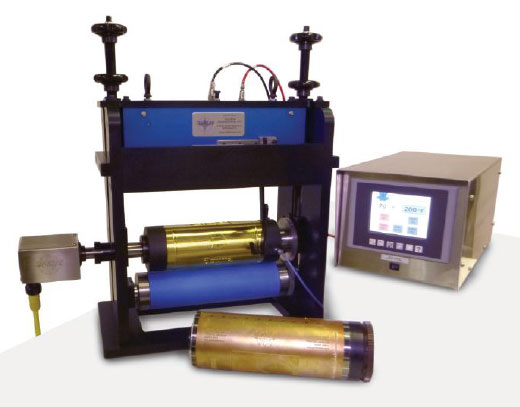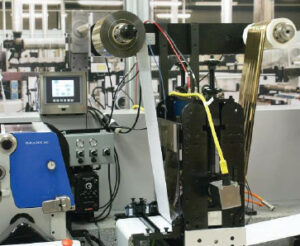
by Tom Kirtz, Telstar Engineering
With more and more consumer product marketers looking for a graphic edge to attract consumers, foil decorating has become a necessary offering among competitive label printers. Rotary hot foil stamping continues to be a popular choice for all types of foil-decorated labels and, if all parameters are correct, the result is a clean, crisp and consistent transfer. To ensure a quality foil transfer and to run the job at maximum speeds, careful consideration should be put into the pre-planning of the job. Here are a few aspects to consider in the early stages of the project.
Test and label stock. Most printable stocks will accept stamped foil, but there are a few that will require a topcoat/primer in order to fill the porosity and give the stock a tooth for adhesion of the foil. It always is recommended to test the stock with the selected foil to see if a topcoat or other coating is necessary. Clear plastic substrates also have continued to be a popular choice for adding decorated foil. A low temperature foil will be necessary for these types of applications to keep the material from wrinkling or melting. Know the stock capabilities before going on press.

Telstar performed CadToGo™ advance engineering for seamless installation of its hot foil stamping unit on this Gallus ECS340 press.
Select the correct foil for the application. Choosing the correct shade is only the beginning. Foil manufacturers have an array of foil selections to maximize the performance of the job being produced. There are foils for porous stocks, plastic stocks, fine details, large solids and overprintable foils. Confer with your preferred supplier to make the correct selection. Keep the foil rolls properly labeled as it nearly is impossible to identify the foil products without a label, especially in similar color shades.
Choose the proper hot stamping anvil for the job. Most jobs will run successfully with a 90 durometer Shore A compound. The compound must be able to withstand 400 degrees F and be resilient so as to not take a set. The surface must be smooth and free of imperfections. If the hot stamping job is on a textured stock, a 100 durometer anvil will be a better choice. The harder durometer anvil allows for the tool to compress the texture without embedding into the anvil.
Run a magnetic cylinder with a flexible die or an engraved brass die. Both flexible dies and engraved brass dies will run well with today’s hot stamping equipment. It is important with any electrically heated hot stamp equipment to maintain a solid flat black band around the circumference of the die for non-contact temperature sensing. A scratched or interrupted temperature band can give false inputs to the temperature controller, causing die temperature variations throughout the run. Engraved brass dies still are recommended for very long runs and/or jobs that continuously will repeat. However, for shorter runs, a flexible die with a metal back can be extremely effective and much less costly for the customer.
Design the job to run with minimum foil use. In some cases, turning one lane to run back-to-back will cut the required foil width by more than half, resulting in a substantial cost savings. Another option is to run multiple narrow lanes of foil only where needed. It also is sometimes possible to run a foil roll more than once if it is carefully rewound on quality rotary rewinding equipment. These types of pre-job considerations can make a huge difference in the total cost of the project and could be the difference in receiving the job or not when an estimate is requested. Minimizing the amount of foil used on a project can even be more critical if a more expensive holographic foil is being used.
Other pointers. There are simple, but critical, engineering solutions that can be important to successfully add foil stamping capabilities onto new or existing press equipment. Consider adding a small diameter foil stripping roller immediately downstream of the transfer point. Many jobs will have a slightly improved crispness to their appearance if the foil is removed immediately after the transfer. Having a second heated shaft assembly to be staged with the next brass engraved tool when running hot stamp jobs back-to-back will save substantially on changeover times as well.
Easy installation. Finally, press downtime always is a major concern for busy label printing plants, so it is very important that retrofit hot stamping units be installed and up and running in a very short period of time. Having detailed engineering information on the press with the addition of this new capability to the production line is key to a quick installation. It is recommended to look for retrofit equipment that is as close to a “bolt-on” job as possible. Be sure to have the press engineer, plant manager and press operators involved from the beginning of the decision-making process. Also, ensure that proper training is included with any new installation. Inline hot foil stamping does add a completely new capability to the press and will take on-press training time to master. However, with the proper pre-planning as discussed in this article, along with proper training, companies can be up and running quality foil stamped labels in a matter of days.
Tom Kirtz is president and chief engineer for Telstar Engineering, the world’s leading manufacturer of narrow to mid-web press retrofit equipment for a wide range of decorating and converting processes. The company also designs, engineers and builds full-frame custom converting presses. Learn more about adding rotary hot stamping to an existing press by visiting www.telstareng.com.

